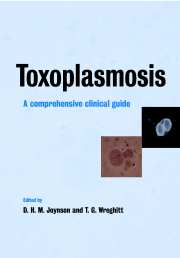Book contents
- Frontmatter
- Contents
- List of contributors
- Preface
- Historical perspective
- 1 Biology of toxoplasmosis
- 2 Immunology of toxoplasma infection
- 3 The epidemiology of toxoplasma infection
- 4 Infection in the immunocompetent
- 5 Toxoplasma infection in HIV-infected patients
- 6 Toxoplasma infection in immunosuppressed (HIV-negative) patients
- 7 Maternal and foetal infection
- 8 Prenatal screening for toxoplasma infection
- 9 Newborn screening for congenital toxoplasma infection
- 10 Infections in neonates and infants
- 11 Ocular infection
- 12 Laboratory diagnosis of toxoplasma infection
- 13 Antitoxoplasma chemotherapy
- 14 Toxoplasma vaccines
- Appendices: protocols for treatment and management
- 1 Suggested treatment protocols
- 2 Management of toxoplasma infection in pregnancy
- 3 Hygiene measures to prevent infection
- 4 Classification system and case definitions of Toxoplasma gondii infection in immunocompetent pregnant women and their congenitally infected offspring
- Index
4 - Infection in the immunocompetent
Published online by Cambridge University Press: 24 September 2009
- Frontmatter
- Contents
- List of contributors
- Preface
- Historical perspective
- 1 Biology of toxoplasmosis
- 2 Immunology of toxoplasma infection
- 3 The epidemiology of toxoplasma infection
- 4 Infection in the immunocompetent
- 5 Toxoplasma infection in HIV-infected patients
- 6 Toxoplasma infection in immunosuppressed (HIV-negative) patients
- 7 Maternal and foetal infection
- 8 Prenatal screening for toxoplasma infection
- 9 Newborn screening for congenital toxoplasma infection
- 10 Infections in neonates and infants
- 11 Ocular infection
- 12 Laboratory diagnosis of toxoplasma infection
- 13 Antitoxoplasma chemotherapy
- 14 Toxoplasma vaccines
- Appendices: protocols for treatment and management
- 1 Suggested treatment protocols
- 2 Management of toxoplasma infection in pregnancy
- 3 Hygiene measures to prevent infection
- 4 Classification system and case definitions of Toxoplasma gondii infection in immunocompetent pregnant women and their congenitally infected offspring
- Index
Summary
Introduction
Infection with Toxoplasma gondii in the immunocompetent individual has generally been regarded as being of little significance. This is probably because many clinicians are influenced by the normally favourable outcome of toxoplasmic lymphadenopathy, the most characteristic clinical presentation. However, toxoplasma infection has a world-wide distribution and since the vast majority of infections are usually not diagnosed (Ho-Yen 1992), the true importance of toxoplasma in the immunocompetent individual is unknown.
A vast amount of information is now available on toxoplasma infection, and the possible outcomes in the immunocompetent individual are shown in Figure 4.1. In those who have not been infected with toxoplasma, significant exposure to the organism usually results in a primary infection. However, there is some evidence that in a few immune individuals and where there is significant strain variation, a second infection is possible (Abdul-Fattah et al. 1992). Reactivated infections are probably more common than second infections, especially in individuals with immune dysfunction that may result from concomitant viral infections, for example human immunodeficiency virus (HIV) or immunosuppressive therapy. Acute toxoplasma infections can be primary, reactivated or second infections (Figure 4.1) and have a wide variety of clinical presentations. In the 1970s, it was generally regarded that acquired toxoplasmosis in the immunocompetent individual resulted in infection rather than disease (Feldman 1974). Now, this belief is being questioned.
- Type
- Chapter
- Information
- ToxoplasmosisA Comprehensive Clinical Guide, pp. 125 - 146Publisher: Cambridge University PressPrint publication year: 2001
- 2
- Cited by

